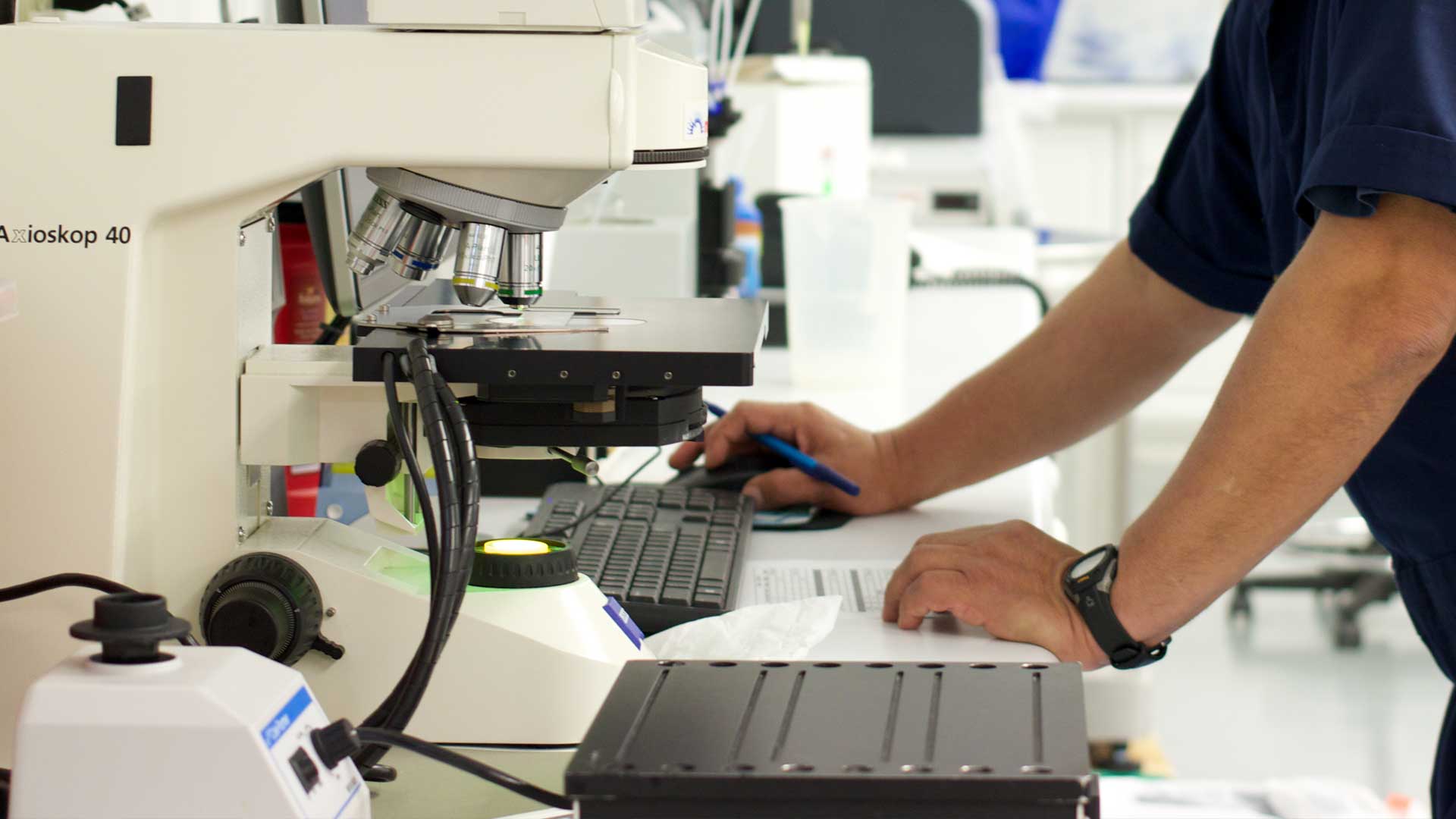
Module 4 – Genetic Dissemination and Lag
Thursday, 2 December 2021
Genetic Dissemination and Lag and how to manage it in a commercial herd.
In Newsletter 4 of the Genetics Technical Module we’re focusing on Genetic Dissemination and Lag and how to manage it in a commercial herd.
Genetic Dissemination
Dissemination means to spread something widely. For the pig industry, genetic dissemination refers to the distribution of superior genes from the genetic nucleus to respective commercial herds. This allows continuous genetic improvement throughout commercial production systems. For all agricultural animal production, both selection for and dissemination of genetic improvement through multiplication occurs through a pyramid structure with nucleus, multiplier and commercial levels (Figure 1).
Selection of stock occurs at all the different levels seen in Figure 1. Genetic improvement only occurs in the genetic nucleus within Pure Line animals and when Pure Line matings are performed. The selection objectives of the nucleus are regularly reviewed to make sure that they reflect the production goals of farms supplied by the genetic nucleus both now and into the future. The objectives of a Genetic Nucleus are to:
- Improve Pure Line traits and implement programs that will optimize the profitability of the customer, when the genes are disseminated through the system
- Develop new lines
- Supply required breeding stock/semen to customers
- Supply of genetically superior boars to service client’s farms through Gene Transfer Centres (GTCs)
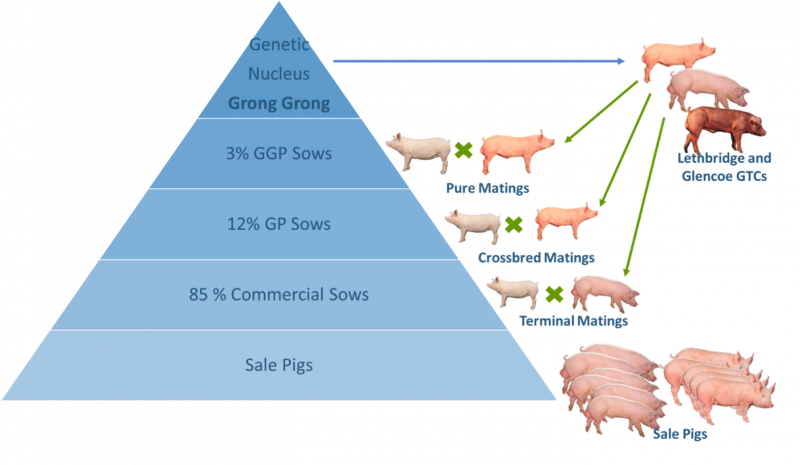
Genetic Lag
The genetic gains selected for in the GN are not experienced on the commercial farms overnight or even within a few months. How quickly the elite genes from the Genetic Nucleus are expressed in the market pigs of a commercial farm is known as the Genetic Lag (Figure 2). This time period is generally between 2-5 years. Meaning
that the genetic level of performance seen in current market pigs, had been selected for in the Genetic Nucleus 2-5 years ago; also, the improvements being made today in the Genetic Nucleus will not be seen in market pigs for 2-5 years. This time frame can be longer if breeding management does not keep in mind genetic management.
The importance of trying to reduce Genetic Lag as much as possible can be seen in Figure 2, where the herd with the low level of Management is over 2 years behind the high-level herd and more than 4 years behind the Genetic Nucleus. This means the genetic potential affecting the production efficiencies within the Low Level herd are well behind that of the High Level managed herd.
Every farm serviced by a genetic nucleus is different; so a one-size-fits-all approach for managing genetic lag and dissemination isn’t suitable. PIC Australia manages genetic lag and dissemination on farms through three different avenues:
- Live animal input
- Closed Herd Multipliers
- Use of Liquid Genes
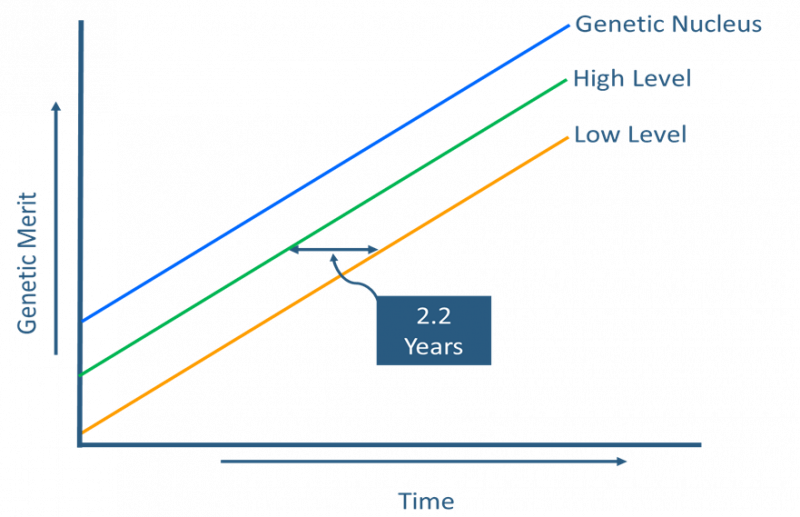
Live animal input
Commercial herds purchase their Camborough gilts direct from the GN and either obtain Liquid Genes from the GTC or boars from the GN, to produce market pigs. Purchasing Camborough© gilts directly from the GN does provide an advantage to these herds, as it minimises genetic lag from the maternal Line. After sourcing replacement gilts from the GN, the greatest way to reduce genetic lag for a Commercial herd is to use Liquid Genes supplied from the GTC rather than natural boar matings or collecting their own boars for AI.
Closed Herd Multipliers (CHM)
The genetic potential of these farms is disseminated through their internal herd replacements, the commercial gilts they produce and finally through the market pigs. By optimizing how the genetic programs on these farms are managed, the performance potential of the internal commercial sow herd and the market pigs it produces, are maximised. Optimum management is achieved by keeping to the correct replacement rate and using Liquid Genes from superior sires in the GTC. Optimising genetic management minimizes genetic lag.
The influence of a CHM on the pork production chain can be quite significant and is demonstrated below (Figure 3). This example shows the number of market pigs impacted by one week of pure matings at a 1,000-head CHM. The production numbers used are conservative estimates to highlight the importance and impact of CHM farms.
- A 1,000-head CHM herd mates 6 sows pure in a week.
- Three pure line select gilts are produced from each of these litters.
- The pure line gilts each produce 10 selected Camborough© gilts through their productive life in the CHM.
- Each of these Camboroughs© produce 60 market-pigs during her lifetime.
- Impact of one-week of matings = 10,800 market pigs!
- 6 matings x 3 select-pure line-gilts per litter x 10 Camboroughs© per sow per lifetime x 60 market pigs per Camborough© per lifetime = 10,800 market pigs
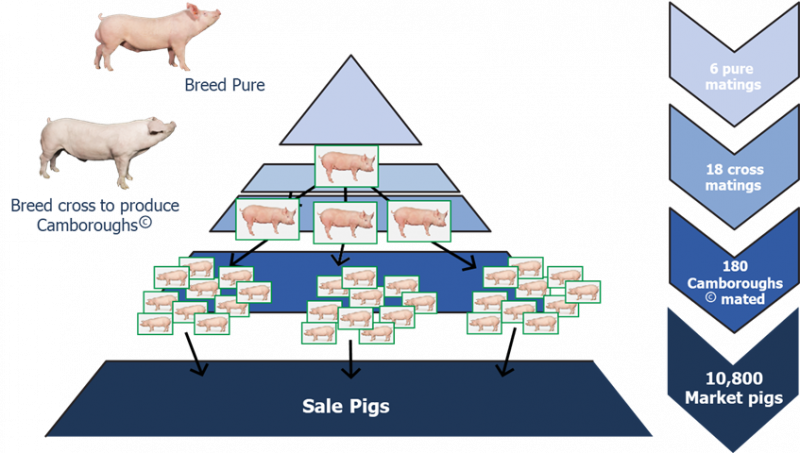
Use of Liquid Genes
Using Liquid Genes from the GTC reduces Genetic lag as these boars are superior sires originating from the GN. Being collected for Liquid Genes rather than performing natural services enable these superior boars to service large volumes of sows weekly, compared to a natural mating, which only allows for a single sow mating/week.
Management that affects Genetic Lag
There are several management factors within non GN farms that influence Genetic Lag. These are:
- Insufficient replacement rates. Most multiplier herds are operated as commercial herds with standard replacement rates which increase genetic lag. Replacement rates within Pure herds should be set at 65% to ensure regular replacement of breeders with genetically superior gilts. “Replacement” regarding Pures doesn’t necessarily mean culling out of the herd; if they’re productive sows they can be bred to produce Camboroughs© (cross mating) or bred with TSL Liquid Genes to produce sale pigs.
- Gene Transfer Centre Vs Boars on Farm. Liquid Genes supplied by PIC managed GTC’s provides access to genes from the GN while minimising genetic lag. For that reason, using Liquid Genes supplied from PIC managed GTCs will ensure effective dissemination of their superior genes into production systems. All boars delivered into the GTC are supplied by the GN herd and are managed using Optimum Boar Life (OBL) tools, developed by PIC. These OBL tools are designed to manage boars in and out of the GTC in relation to their genetic merit and their effect on profitability at the commercial level. PIC’s ability to manage, maintain and replace boars in GTCs means that the system is always delivering latest genetic material.
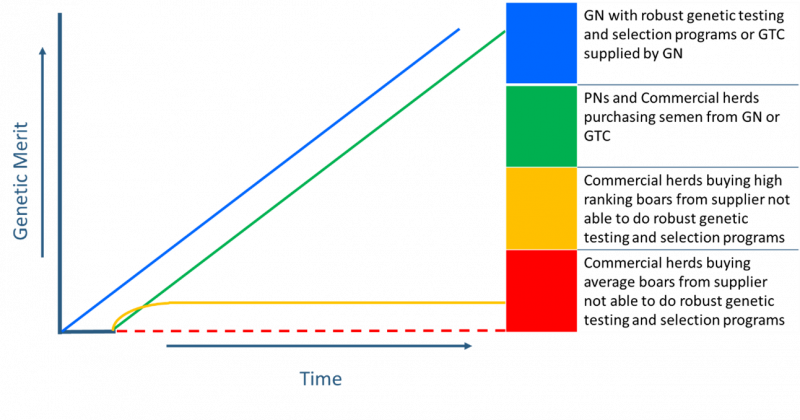
Purchasing and housing boars on farm can lead to high levels of genetic lag, either through home collection or natural service. This is because boars tend not to be turned over at the replacement rate to minimise genetic lag (recommended to be 75%/year).
Boar genetic merit becomes an issue if boars rather than GTC Liquid Genes are used. This issue is compounded when the boars are not turned over quickly enough or if boars are purchased from a suppler unable to implement robust genetic improvement and selection programs (Figure 4).
- Multiple tiers. CHMs have internal tiers to “multiply” or produce Parent Gilts which can be the result of a two-way Line breed cross, or a three-way Line breed cross. The three-way cross adds an additional tier to the pyramid. Every additional multiplication tier that is added to the system moves the Camborough© replacements further away from the GN genetic improvement program, increasing genetic lag for herds which use the three-way cross. There are some benefits for a three-way Line breed cross, but these must be weighed up with the accompanying increased genetic lag.
- Genetic Selection Intensity. This means ensuring that female breeders with the best genetic merit make up most of the pure Line matings. This is achieved by setting a minimum Pure mating target for each mating batch of 26% gilts, with the remaining 74% of the Pure matings made up of the best Pure sows in that batch.These targets will result in a Replacement Rate of 65%, which is the recommended Replacement Rate for a nucleus.
- Selection Accuracy. All factors that relate to this point are controlled on farm; its about making sure you have enough of the correct type of gilt to disseminate genetic improvement and reduce genetic lag in your system. These factors include:
- Using the correct semen to inseminate the correct sows and gilts;
- Identifying the pure-bred piglets at birth;
- Selecting required gilts on a weekly/monthly basis;
- Mating adequate numbers to meet requirements;
- Concentrate on quality in selections, and
- Proper care of the pure-bred breeders.
References
- Efficiency of Genetic Transfer Using AI Technology. M. Todd See, Ph.D. https://projects.ncsu.edu/project/swine_extension/genetics/selection/efficiency.htm
- What the Commercial Pig Producer needs to know about genetic improvement. M. Todd See, Ph.D. https://projects.ncsu.edu/project/swine_extension/publications/factsheets/820s.htm
- 2019 PIC Production Nucleus Guidelines
- Multi-site Pig Production. D. L. Harris (2008)
- The Genetics of the Pig. M. F. Rothschild, A. Ruvinsky (2010)
The opinions, advice and information contained in this publication are offered by PIC Australia soley for informational purposes and it does not constitute professional, commerciial or technical advice. While information contained in this publication has been formulated in good faith, the contents do not take account all the factors which need to be considered before putting the information into practice. Accordingly, no person should rely on anything contained herein as a substitute for specific advice.

